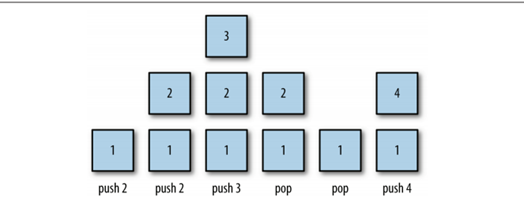Home >Web Front-end >JS Tutorial >Data structures and algorithms in JavaScript (1): stack_javascript skills
Data structures and algorithms in JavaScript (1): stack_javascript skills
- WBOYWBOYWBOYWBOYWBOYWBOYWBOYWBOYWBOYWBOYWBOYWBOYWBOriginal
- 2016-05-16 15:54:01971browse
Preface
Data Structures and Algorithms JavaScript is a book that explains it in a relatively simple way. The advantage is that it uses JavaScript language to describe commonly used data structures. Many examples in the book come from common interview questions, which can be regarded as keeping pace with the times. , I watched it as an amateur and recorded it by the way
git code download: https://github.com/JsAaron/data_structure.git
Stack structure
Special list, the elements in the stack can only be accessed through one end of the list, the top of the stack
Last-in-first-out (LIFO, last-in-first-out) data structure
Javascript provides operable methods, push and pop, but pop will remove the data in the stack

An implementation class that implements a stack
The underlying data structure uses arrays
Because pop deletes the data in the stack, you need to implement a search method peek
Implement a cleaning method clear
Find the total number of elements in the stack length
Check if there is still element empty
function Stack(){
This.dataStore = []
This.top = 0;
This.push = push
This.pop = pop
This.peek = peek
This.length = length;
}
function push(element){
This.dataStore[this.top] = element;
}
function peek(element){
Return this.dataStore[this.top-1];
}
function pop(){
Return this.dataStore[--this.top];
}
function clear(){
This.top = 0
}
function length(){
Return this.top
}
Palindrome
A palindrome refers to a word, array, or phrase that is the same from front to back 12321.abcba
The simplest idea of a palindrome is that if the element is reversed and equal to the original element, it means that it is a palindrome
You can use this stack class to operate here
function isPalindrome(word) {
var s = new Stack()
for (var i = 0; i < word.length; i ) {
s.push(word[i])
}
var rword = "";
while (s.length() > 0) {
rword = s.pop();
}
If (word == rword) {
return true;
} else {
return false;
}
}
isPalindrome("aarra") //false
isPalindrome("aaraa") //true
Look at this isPalindrome function. It actually calls the Stack class, and then pushes the word element passed in to each decomposed unit into the stack. According to the principle of the stack, the principle of last in, first out , use the pop method to disassemble this element, and finally compare the before and after assembly. If they are equal, it is a palindrome
Recursion
Use recursion to implement a factorial algorithm
5! = 5 * 4 * 3 * 2 * 1 = 120
Use recursion
function factorial(n) {
If (n === 0) {
Return 1;
} else {
return n * factorial(n - 1);
}
}
Use stack operations
function fact(n) {
var s = new Stack()
while (n > 1) {
//[5,4,3,2]
s.push(n--);
}
var product = 1;
while (s.length() > 0) {
Product *= s.pop();
}
Return product;
}
fact(5) //120
Push n = 5 decrementally onto the stack through while, and then through a loop or according to the last-in-first-out principle of the stack, take out the frontmost one and stack it with the product through the pop method
Related articles
See more- An in-depth analysis of the Bootstrap list group component
- Detailed explanation of JavaScript function currying
- Complete example of JS password generation and strength detection (with demo source code download)
- Angularjs integrates WeChat UI (weui)
- How to quickly switch between Traditional Chinese and Simplified Chinese with JavaScript and the trick for websites to support switching between Simplified and Traditional Chinese_javascript skills

